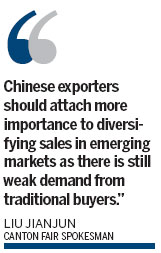New markets buy big at trade fair
Updated: 2013-05-06 08:08
By Li Jiabao in Beijing and Qiu Quanlin in Guangzhou (China Daily)
|
||||||||

Emerging economies step forward to counteract slowdown in orders
Buyers from emerging markets are stepping forward to pick up the slack as orders from developed nations slow.
At the just-ended Canton Fair, a biannual event seen as a barometer of China's foreign trade, orders from BRICS members India, Brazil, Russia and South Africa increased 5.2 percent year-on-year, while those from Middle Eastern countries rose 3.8 percent.
"The number of buyers from emerging markets, especially from Africa, and Australia, also increased a lot, sending a signal that demand for Chinese products in these regions is increasing," Liu Jianjun, spokesman of the Canton Fair and deputy director of the China Foreign Trade Center, said at Sunday's briefing.
"Chinese exporters should attach more importance to diversifying sales in emerging markets as there is still weak demand from traditional buyers, especially those from Europe," he said.
Officially called the China Import and Export Fair, the Canton Fair concluded on Sunday in Guangzhou. It attracted 202,000 overseas merchants, up 7 percent from the fall session.
Transactions reached $35.54 billion, up 8.8 percent from the last session, but still down 1.4 percent from the spring session last year, organizers reported on Sunday.
Transactions were down 4.9 percent with Europe, 0.5 percent with the United States and 12.6 percent with Japan year-on-year, as the number of visitors from these areas decreased, the official said.
Transactions with ASEAN members also suffered a decline, down 6.5 percent year-on-year.
The outlook for Chinese exports is still uncertain, the official said, as exporters face problems ranging from higher costs, a rising yuan, tight credit and sluggish demand from traditional markets.
Emerging markets account for 20 percent of China's overall trade while the share of developed markets - the US, EU and Japan - shrank 2.1 percentage points in 2012 from a year earlier, the spokesman said.
Under the global economic downturn, foreign buyers took a "very cautious approach" when dealing with Chinese exporters, he admitted.
"Emerging markets brought about the fastest export growth in recent years and the pace accelerated in the first quarter as we strategically increased the sales of our own brands in these markets," said Wang Yuechun, managing director of the overseas strategy and development department of Sichuan Changhong Electric.
"Russia is the most promising one among the emerging markets followed by Southeast Asia and Africa, and exports to Russia will maintain fast growth," Wang said.
Li Jie, manager of the marketing department at the International Business Division of Kongka Group, said prospects for exports this year are still challenging owing to buyers' declining willingness to place orders, rising costs at home and currency appreciation.
"Robust shipments to emerging markets, such as the Middle East, Africa, Latin America and Southeast Asia, powerfully supported our export growth - 20 to 30 percent - in the first quarter of this year, contrasting the 10 percent growth in 2012," Li said.
Liu Juan, general manager of the export department of Guangdong Winto Ceramics, said that buyers from emerging economies have much stronger purchasing power than those from the EU, and the company will target Southeast Asia and the Middle East.
"I used to buy machines from the EU, but from this year I will change to China," said Yezichalem Kassa, CEO of Day Agro Industry, a fruit processing plant in Ethiopia.
"Chinese fruit processing machines are less expensive than the EU ones, which is the major advantage. And we hear so many positive things about Chinese machinery, and the EU machinery is becoming unaffordable. So now the Chinese machines are of good quality and reasonable prices," she added.
Andrei Alcea, general manager of Plasme Termice, a Romanian company in household items, said that some China-made electronic heaters are similar to EU ones, in addition to having a lower price.
Mechanical and electrical products accounted for 50.7 percent of China's total trade in 2012, according to the Ministry of Commerce.
Contact the writer at lijiabao@chinadaily.com.cn
(China Daily 05/06/2013 page1)

 Michelle lays roses at site along Berlin Wall
Michelle lays roses at site along Berlin Wall
 Historic space lecture in Tiangong-1 commences
Historic space lecture in Tiangong-1 commences
 'Sopranos' Star James Gandolfini dead at 51
'Sopranos' Star James Gandolfini dead at 51
 UN: Number of refugees hits 18-year high
UN: Number of refugees hits 18-year high
 Slide: Jet exercises from aircraft carrier
Slide: Jet exercises from aircraft carrier
 Talks establish fishery hotline
Talks establish fishery hotline
 Foreign buyers eye Chinese drones
Foreign buyers eye Chinese drones
 UN chief hails China's peacekeepers
UN chief hails China's peacekeepers
Most Viewed
Editor's Picks

|

|

|

|

|

|
Today's Top News
Shenzhou X astronaut gives lecture today
US told to reassess duties on Chinese paper
Chinese seek greater share of satellite market
Russia rejects Obama's nuke cut proposal
US immigration bill sees Senate breakthrough
Brazilian cities revoke fare hikes
Moody's warns on China's local govt debt
Air quality in major cities drops in May
US Weekly

|

|







